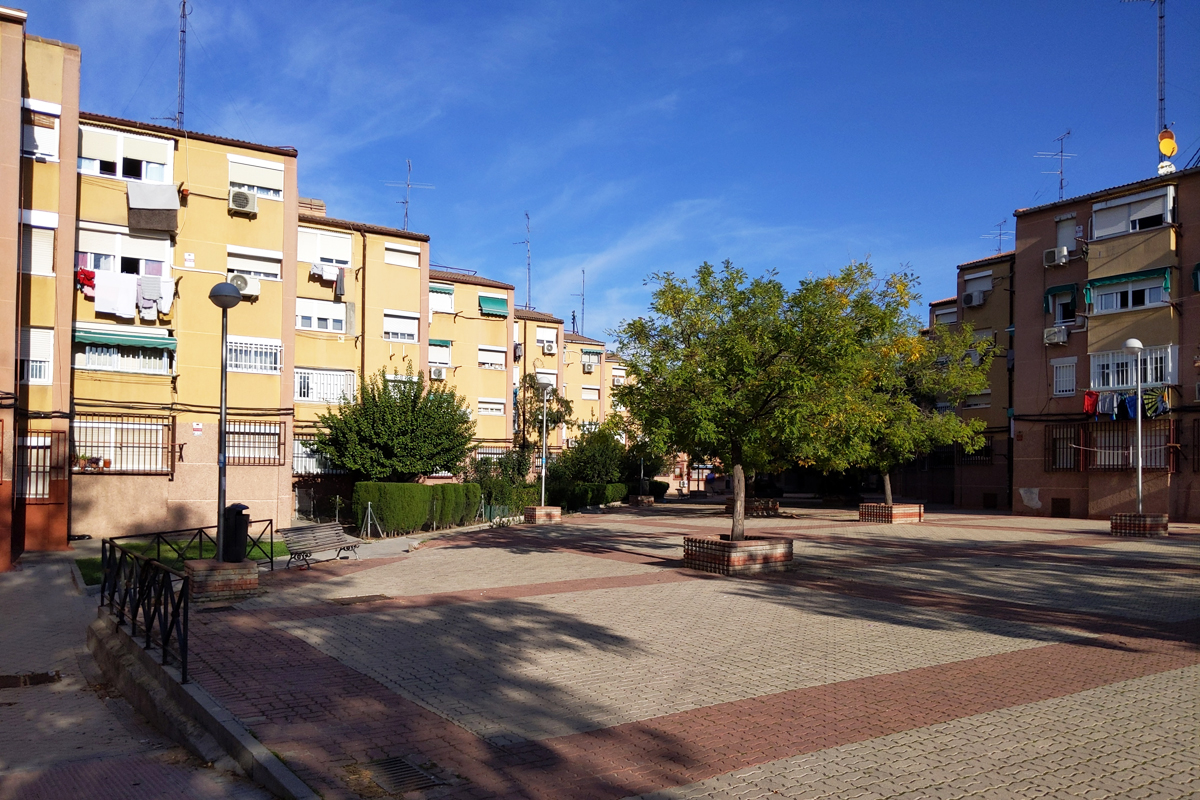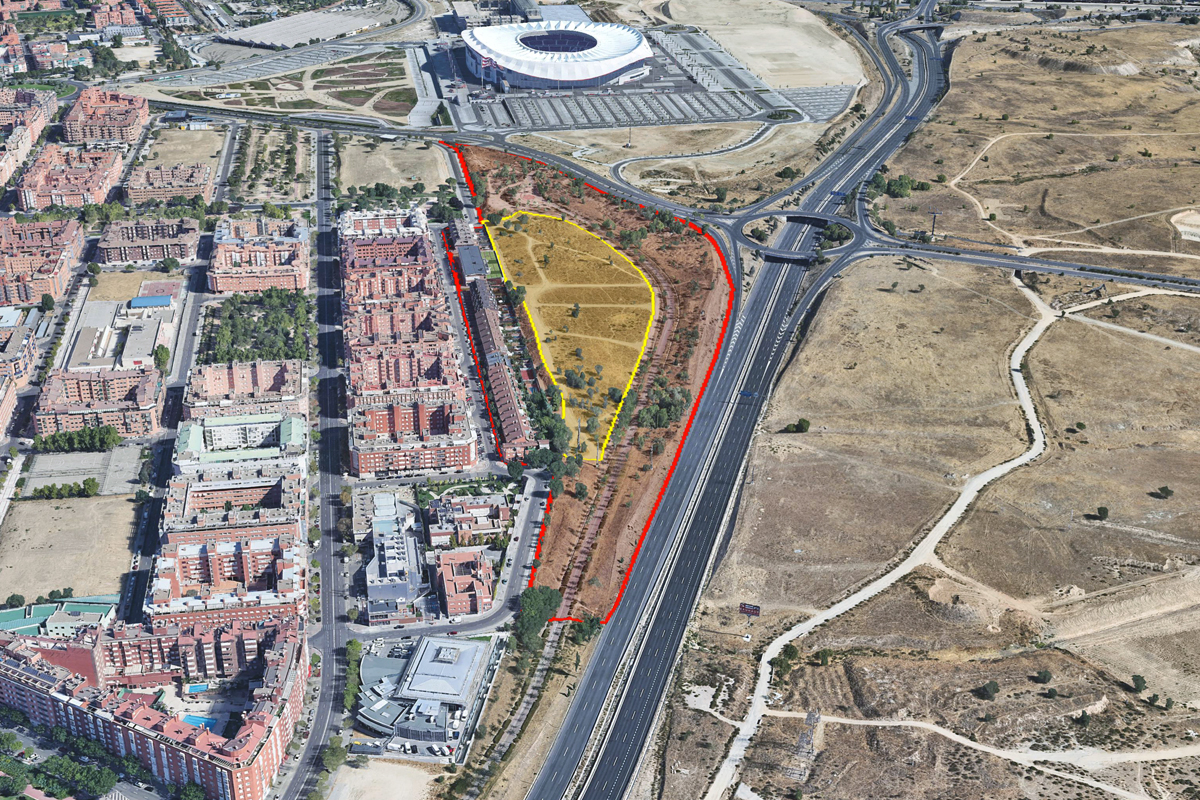Madrid (ES)
Les Dossiers synthétiques et d'enjeux sont disponibles gratuitement.
Merci de vous inscrire et vous connecter pour accéder au Dossier complet de site.
- Dossier synthétique EN | ES
- Dossier d’enjeux EN | ES
- Le site sur Google Maps
- Retour à la carte
Données synthétiques

Madrid (ES)
Scale (S) Architectural, in terms of the size of each operation and the elements to be designed // (L) Urban planning, in terms of the scope of the project and its potential implementation throughout the city.
Team representative Architects, landscapers. It would be advisable to include a profile with knowledge about agronomy and industrial design.
Location Urban lands in Madrid city, divided as such: (1) & (2) Plot F &. G, Gran San Blas, in the San Blas - Canillejas District // (3) Las Rosas, San Blas – Canillejas District // (4) Fuencarral district // (5) IFEMA trade fair precinct, Barajas District
Nevertheless, the designs for the model and the components designated for the competition are intended to be applicable in every part of the city where the Madrid Producer Districts project is implemented.
Information complémentaire
Population 3,275,195, with a population density of 5,418.47 inhabitants/sq. km
Strategic site The dimensions of the study and project areas are variable. They are defined in each case by the surrounding urban environment, which influences and shapes formal, visual and also social aspects. The relations and dialogue with the built-up environment, with the people who live there, the existence or, where appropriate, the creation of useable or meeting spaces, the possibility of distributing local products, etc., must all be taken into consideration.
Project site The competition site plots have the following areas:
- Plot G, Gran San Blas: 5,557.48 sqm
- Plot F, Gran San Blas: 11,137.24 sqm
- Las Rosas Plot: 36,329.38 sqm
- Plot in old part of Fuencarral: 1,085.85 sqm
- IFEMA roofs: 242,552.37 sqm
These plots are presented as examples of urban morphotypes in which most of the productive nodes of the Producer Districts project can be implemented. ha
Site proposed by Directorate-General of Strategic Planning, Urban Development Area, Madrid City Council
Actors involved Madrid City Council
Site(s) Owner(s) Madrid City Council. One of the plots is still pending the outcome of the property process. The roofs of the trade fair precinct belong to the IFEMA Consortium, in which the Madrid City Council is a participant.
Commission after competition Several options are considered, depending on the scope, content and characteristics of the winning project:
- Commission for the project on one or more of the competition sites.
- Production of a brand manual or design guide for the Producer Districts projects to be implemented in the city, with the approval and standardisation, where appropriate, of the elements which may be given this status.
Urban City Strategy
The ‘Producer Districts project’ responds to these multiple urban voids of various origins and turns them into productive nodes where agricultural activity is integrated with the city. At the same time, they become zones of coexistence for their immediate environs.
The competition will be used to create a model of urban horticulture or a productive space, including the design of all its elements, which will be scalable and capable of integrating with the city’s territorial diversity, while at the same time being an expressive, unifying resource for the project that will give it an identifying image.
The proposed sites are located in urban land in Madrid city. The dimensions of the study and project areas are variable. They are defined in each case by the surrounding urban environment, which influences and shapes formal, spatial, social and economic aspects. The relations and dialogue with the built-up environment, with the people who live there, must all be taken into consideration.
Site Definition
The proposed study sites are the following:
1. Plot in a marginal district with a dense, open-block design in a central inter-block position on Plot G, Gran San Blas, in the San Blas - Canillejas District
2. Plot in a marginal district with a dense, open-block design in a perimeter position on Plot F, Gran San Blas, in the San Blas – Canillejas District
3. Plot in the urban periphery, a recent expansion zone of Las Rosas, San Blas – Canillejas District
4. Plot in the old part of Fuencarral district
5. Roofs of buildings in the IFEMA trade fair precinct, Barajas District
Nevertheless, the designs for the model and the components designated for the competition are intended to be applicable in every part of the city where the “Madrid- Barrios Productores” (Madrid-Producer Districts) project is implemented. Only one of these sites can therefore be chosen to develop a complete replicable implementation project
How Must Metabolism and Inclusivity Be Developed and Connected?
The choice of the competition plots is linked to the Madrid City Council's project, “Barrios Productores” (Producer Districts). The aim is to progress towards a change of model in the way we work on the city based on the recovery and regeneration of urban voids in empty or misused plots through a strengthened dialogue between city and nature.
We seek to integrate food production with the urban fabric, which will give rise to a dual effect: the renaturalisation of dense urban fabrics and the involvement of residents in initiatives that will collaborate with the conservation of public spaces, improve their everyday landscape and potentially be sources of employment.
Urban gardens are thought of as a complex program of uses capable of answering all the dimensions that the program seeks to embrace: social gathering, educational purposes, experimental ones, short-circuit food production, participating to the enhancement of environmental conditions and biodiversity, recycling and efficient water use, reduction of the so-called “heat island” effect, the use and production of renewable energy, etc., without missing its landscape component, helping the social validation of the inhabited surroundings and actually producing new ecosystems, half-way between nature and culture.
The ‘Producer Districts’ project has more than 250 plots available, most of them located in the city's peripheral districts, with a wide diversity of urban landscapes. This competition proposes five sites with different typologies and sizes, which can serve as examples for analysis.










Questions à propos du site
Is it possible to enter to only one or two of the 5 proposed sites? Se puede presentar un proyecto solo para una o dos de las 5 áreas propuestas?
Si, se puede. Es objetivo es que las ideas premiadas sean replicables en áreas de simililar morfo-tipología de los barrios productores del Madrid
1. Which are the typical plants cultivated in the area of Madrid?
Tomatoes, peppers, aubergines, onions, different types of lettuce, chard, green beans, cucumbers, courgettes and in general all kinds of vegetables growing with a continental Mediterranean climate. There are also fruit trees and numerous species of aromatic herbs that serve as condiments and provide biodiversity to the crops.
Tomates, pimientos, berenjenas, cebollas, diferentes tipos de lechugas, acelgas, judías verdes, pepinos, calabacines y en general todo tipo de hortalizas de clima mediterráneo continental. También árboles frutales y numerosas especies de plantas aromáticas que sirven de condimento y proporcionan biodiversidad a los cultivos.
What are the most common jobs that foreign inhabitants do?
The city of Madrid has a population of over 3.3 million inhabitants. The foreign population represents slightly more than 15% and works in all sectors, particularly in the service sector. These elements, however, are not particularly relevant for the development of the project and the competition.
La ciudad de Madrid tiene una población de más de 3,3 millones de habitantes. La población extranjera representa algo más del 15 % y desempeña trabajos en todos los sectores, con especial intensidad en el sector servicios. Estos aspectos, sin embargo, no tienen especial relevancia para el desarrollo del proyecto y del concurso.
Do you have a calendar of the annual events of the city or communities living in Madrid?
Hundreds of events of national and international relevance are held in the city every year, as befits a large European capital of more than 3 million inhabitants located in a metropolitan area of 6 million inhabitants. They are regularly published on the Internet. The fairs, congresses and events organised at the IFEMA, the roofs of which are proposed as one of the project sites, can be consulted at www.ifema.es.
En la ciudad se celebran anualmente cientos de eventos de relevancia nacional e internacional como corresponde a una gran capital europea de más de 3 millones de habitantes situada en un área metropolitana donde viven 6 millones de personas. Se publican con periodicidad en internet. Las ferias, congresos y eventos organizados en el recinto ferial IFEMA, cuyas cubiertas se proponen como uno de los emplazamientos, se pueden consultar en www.ifema.es.
Le site est lié au thème suivant
Revitalisation Sur ces sites, l'impulsion de la transformation vient du territoire et de l'utilisation de toutes les ressources (naturelles, écologiques, infrastructurelles) pour le régénérer.
Renforcer la biodiversité
Ici, le moteur du changement est la transformation de l'écologie (urbaine).
Documents spécifiques
Questions à propos du site
Pour pouvoir poser une question, vous devez être connecté (et, par conséquent, inscrit au concours).
Ve. 16 mai 2025
Date limite de soumission des questions
Ve. 30 mai 2025
Date limite de réponses aux questions
Avant de soumettre votre question, assurez-vous qu'elle n'apparaît pas déjà dans la FAQ.
Merci de poser vos questions sur les sites dans le menu Sites.
Merci de poser vos questions sur le règlement dans le menu Règlement.
Si votre question ne reçoit pas de réponse dans les 10 jours, merci de vérifier qu'elle ne figure pas dans la FAQ sous un autre intitulé ; sinon, contactez le secrétariat concerné par email (secrétariats nationaux pour les sites, secrétariat européen pour le règlement.)